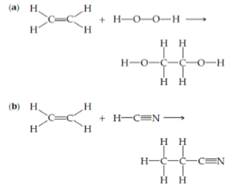
Chemistry: The Central Science Plus Mastering Chemistry with Pearson eText -- Access Card Package (14th Edition)
14th Edition
ISBN: 9780134292816
Author: Theodore E. Brown, H. Eugene LeMay, Bruce E. Bursten, Matthew E. Stoltzfus
Publisher: PEARSON
expand_more
expand_more
format_list_bulleted
Concept explainers
Textbook Question
Chapter 8, Problem 69E
Using Table 8.3, estimate


Expert Solution & Answer
Want to see the full answer?
Check out a sample textbook solution
Students have asked these similar questions
Please label this HNMR
Consider the following gas chromatographs of Compound A, Compound B, and a mixture of Compounds A and B.
Inject
A
B
mixture
Area= 9
Area = 5
Area = 3
Area
Inject
.
མི།
Inject
J2
What is the percentage of Compound B in the the mixture?
Rank these according to stability.
CH3
H3C
CH3
1
CH3
H3C
1 most stable, 3 least stable
O 1 most stable, 2 least stable
2 most stable, 1 least stable
O2 most stable, 3 least stable
O3 most stable, 2 least stable
O3 most stable, 1 least stable
CH3
2
CH3
CH3
H₂C
CH3
3
CH3
CH
Chapter 8 Solutions
Chemistry: The Central Science Plus Mastering Chemistry with Pearson eText -- Access Card Package (14th Edition)
Ch. 8.2 - Which of the these elements is most likely to from...Ch. 8.2 - Prob. 8.1.2PECh. 8.2 - Which of the following bond is the most polar? H-F...Ch. 8.2 - Prob. 8.2.2PECh. 8.3 - Prob. 8.3.1PECh. 8.3 - Prob. 8.3.2PECh. 8.4 - Which of the following bonds is the most polar? a....Ch. 8.4 - Which of the following bonds is most polar: S-Cl,...Ch. 8.4 - Prob. 8.5.1PECh. 8.4 - The dipole moment of chlorine monofluoride,...
Ch. 8.5 - Which of the these molecules has a Lewis structure...Ch. 8.5 -
How many valence electrons should appear in the...Ch. 8.5 - Compare the lewis symbol for neon the structure...Ch. 8.5 - Prob. 8.7.2PECh. 8.5 - Prob. 8.8.1PECh. 8.5 - Prob. 8.8.2PECh. 8.5 - Prob. 8.9.1PECh. 8.5 - Prob. 8.9.2PECh. 8.6 - Which of the statements about resonance is true?...Ch. 8.6 - Prob. 8.10.2PECh. 8.7 - Prob. 8.11.1PECh. 8.7 - Prob. 8.11.2PECh. 8 - Prob. 1DECh. 8 - Prob. 1ECh. 8 - Prob. 2ECh. 8 - A portion of a two-dimensional "slab" of NaCl(s)...Ch. 8 - Prob. 4ECh. 8 - Prob. 5ECh. 8 - Incomplete Lewis structures for the nitrous acid...Ch. 8 - Prob. 7ECh. 8 - Prob. 8ECh. 8 - Prob. 9ECh. 8 - True or false: The hydrogen atom is most stable...Ch. 8 - Consider the element silicon, Si. Write its...Ch. 8 - Write the electron configuration for the element...Ch. 8 - Prob. 13ECh. 8 - What is the Lewis symbol for each of the following...Ch. 8 - Using Lewis symbols, diagram the reaction between...Ch. 8 - Use Lewis symbols to represent the reaction that...Ch. 8 - Predict the chemical formula of the ionic compound...Ch. 8 - Prob. 18ECh. 8 - Prob. 19ECh. 8 - Prob. 20ECh. 8 - Is lattice energy usually endothermic or...Ch. 8 - NaCI and KF have the same crystal structure. The...Ch. 8 - Prob. 23ECh. 8 - Prob. 24ECh. 8 - Consider the ionic compounds KF, NaCl, NaBr, and...Ch. 8 - Which of the following trends in lattice energy is...Ch. 8 - Energy is required to remove two electrons from Ca...Ch. 8 - Prob. 28ECh. 8 - Use data from Appendix C, Figure 7.10, and Figure...Ch. 8 - Prob. 30ECh. 8 - Prob. 31ECh. 8 - Prob. 32ECh. 8 - Using Lewis symbols and Lewis structures, diagram...Ch. 8 - Use Lewis symbols and Lewis structures to diagram...Ch. 8 - Prob. 35ECh. 8 - Prob. 36ECh. 8 - Prob. 37ECh. 8 - What is the trend in electronegativity going from...Ch. 8 - Prob. 39ECh. 8 - By referring only to the periodic table, select...Ch. 8 - which of the following bonds are polar? B-F,...Ch. 8 - Arrange the bonds in each of the following sets in...Ch. 8 - Prob. 43ECh. 8 - Prob. 44ECh. 8 - In the following pairs of binary compounds,...Ch. 8 - Prob. 46ECh. 8 - Prob. 47ECh. 8 - Write Lewis structures for the following: H2CO...Ch. 8 - Prob. 49ECh. 8 - Draw the dominant Lewis structure for the...Ch. 8 - Write Lewis structures that obey the octet rule...Ch. 8 - Prob. 52ECh. 8 - Prob. 53ECh. 8 - Prob. 54ECh. 8 - Prob. 55ECh. 8 - Prob. 56ECh. 8 - Prob. 57ECh. 8 - Prob. 58ECh. 8 - Prob. 59ECh. 8 - Prob. 60ECh. 8 - Prob. 61ECh. 8 - 8.62 For Group 3A-7A elements in the third row of...Ch. 8 - Draw the Lewis structures for each of the...Ch. 8 - Prob. 64ECh. 8 - In the vapor phase, BeCl2exists as a discrete...Ch. 8 -
8.66
Describe the molecule xenon trioxide, XeO3,...Ch. 8 -
8.67 There are many Lewis structures you could...Ch. 8 - Prob. 68ECh. 8 - Using Table 8.3, estimate H for each of the...Ch. 8 - Using Table 8.3, estimate H for the following...Ch. 8 - State whether each of these statements is true or...Ch. 8 - Prob. 72ECh. 8 - Prob. 73ECh. 8 - Prob. 74ECh. 8 - Prob. 75ECh. 8 - Prob. 76ECh. 8 - A new compound is made that has a C-C bond length...Ch. 8 - A new compound is made that has an N-N bond length...Ch. 8 - Prob. 79AECh. 8 - Prob. 80AECh. 8 - An ionic substance of formula MX has a lattice...Ch. 8 - Prob. 82AECh. 8 - Prob. 83AECh. 8 - Prob. 84AECh. 8 - Consider the collection of nonmetallic elements 0,...Ch. 8 - The substance chlorine monoxide, CIO(g), is...Ch. 8 -
[8.87]
a. using the electronegativities of Br...Ch. 8 - Prob. 88AECh. 8 - Although I3- is a known ion, F3- is not. a. Draw...Ch. 8 - Calculate the formal charge on the indicated atom...Ch. 8 - The hypochlorite ion, CIO- , is the active...Ch. 8 - Prob. 92AECh. 8 - a. Triazine, C3 H3N3, is like benzene except that...Ch. 8 - Prob. 94IECh. 8 - Prob. 95IECh. 8 - Prob. 96IECh. 8 - Prob. 97IECh. 8 - Prob. 98IECh. 8 - Prob. 99IECh. 8 - Prob. 100IECh. 8 - Prob. 101IECh. 8 - Prob. 102IECh. 8 -
8.103 The compound chloral hydrate, known in...Ch. 8 - Barium azide is 62.04% Ba and 37.96% N. Each azide...Ch. 8 - Acetylene (C2H2) and nitrogen (N2) both contain a...Ch. 8 - Prob. 106IECh. 8 - Prob. 107IECh. 8 -
8.108 Formic acid has the chemical formula...Ch. 8 - Prob. 109IECh. 8 - Prob. 110IE
Knowledge Booster
Learn more about
Need a deep-dive on the concept behind this application? Look no further. Learn more about this topic, chemistry and related others by exploring similar questions and additional content below.Similar questions
- Consider this IR and NMR: INFRARED SPECTRUM TRANSMITTANCE 0.8- 0.6 0.4 0.2 3000 10 9 8 00 HSP-00-541 7 CO 6 2000 Wavenumber (cm-1) сл 5 ppm 4 M Which compound gave rise to these spectra? N 1000 1 0arrow_forwardConsider this reaction (molecular weights are under each compound): HC=CH + 2 HCI --> C2H4Cl 2 MW = 26 36.5 99 If 4.4 g of HC=CH are reacted with 110 mL of a 2.3 M HCI solution, and 6.0 g of product are actually produced, what is the percent yield?arrow_forwardWhat is the name of the major product of this reaction? OH CH3 H₂SO4, heat 1-methylcyclohexene O2-methyl-1-cyclohexene O 3-mthylcyclohexene 1-methyl-2-cyclohexenearrow_forward
- We added a brown solution of Br2 to one of our products, and the brown color disappeared. This indicated that our product wasarrow_forwardRank the following according to reactivity toward nitration: a) benzene b) bromobenzene c) nitrobenzene d) phenol Od) greatest, c) least Od) greatest, b) least Od) greatest, a) least a) greatest, b) least a) greatest, c) least Oa) greatest, d) least Ob) greatest, a) least O b) greatest, c) least Ob) greatest, d) least O c) greatest, a) least O c) greatest, b) least O c) greatest, d) leastarrow_forwardO-Nitrophenol was distilled over with the steam in our experiment while the other isomer did not. This is due to: O intramolecular hydrogen bonding in the ortho isomer O intermolecular hydrogen bonding in the the ortho isomer O the ortho isomer has a lower density O the ortho isomer has a lower molecular weightarrow_forward
- K 44% Problem 68 of 15 Submit Curved arrows are used to illustrate the flow of electrons. Using the provided starting and product structures, draw the curved electron-pushing arrows for the following reaction or mechanistic step(s). Be sure to account for all bond-breaking and bond-making steps. :6: :: :CI: CI CI: :0:0 Select to Add Arrows Select to Add Arrows H H Cl CI: CI CI: Select to Add Arrows Select to Add Arrows H :CI: Alarrow_forwardI I H :0: Submit Curved arrows are used to illustrate the flow of electrons. Using the provided starting and product structures, draw the curved electron-pushing arrows for the following reaction or mechanistic step(s). Be sure to account for all bond-breaking and bond-making steps. 0:0 :0: CI ΑΙ :CI: :CI: :0: CI Select to Add Arrows Select to Add Arrows cl. :0: Cl © ハ CI:: CI H CO Select to Add Arrows Select to Add Arrows 10: AI ::arrow_forwardOrder the following compounds from slowest to fastest in a nucleophilic acyl substitution reaction. ii 요 OB D A E C OCE Darrow_forwardI need the most help figuring out how to find [I^-] mol/ L, [S2O8^2-] mol/L. 1st and 2nd Blank columns.arrow_forwardCan someone help me whats the issue?arrow_forwarda. The change in the Gibbs energy of a certain constant pressure process is found to fit the expression: AG-85.1 J mol −1 +36.5 J mol ¹K-1 × T A. Calculate the value of AS for the process. B. Next, use the Gibbs-Helmholtz equation: (a(AG/T)) ΔΗ - T2 to calculate the value of AH for the process.arrow_forwardarrow_back_iosSEE MORE QUESTIONSarrow_forward_ios
Recommended textbooks for you
 General Chemistry - Standalone book (MindTap Cour...ChemistryISBN:9781305580343Author:Steven D. Gammon, Ebbing, Darrell Ebbing, Steven D., Darrell; Gammon, Darrell Ebbing; Steven D. Gammon, Darrell D.; Gammon, Ebbing; Steven D. Gammon; DarrellPublisher:Cengage Learning
General Chemistry - Standalone book (MindTap Cour...ChemistryISBN:9781305580343Author:Steven D. Gammon, Ebbing, Darrell Ebbing, Steven D., Darrell; Gammon, Darrell Ebbing; Steven D. Gammon, Darrell D.; Gammon, Ebbing; Steven D. Gammon; DarrellPublisher:Cengage Learning Introductory Chemistry: A FoundationChemistryISBN:9781337399425Author:Steven S. Zumdahl, Donald J. DeCostePublisher:Cengage Learning
Introductory Chemistry: A FoundationChemistryISBN:9781337399425Author:Steven S. Zumdahl, Donald J. DeCostePublisher:Cengage Learning ChemistryChemistryISBN:9781305957404Author:Steven S. Zumdahl, Susan A. Zumdahl, Donald J. DeCostePublisher:Cengage Learning
ChemistryChemistryISBN:9781305957404Author:Steven S. Zumdahl, Susan A. Zumdahl, Donald J. DeCostePublisher:Cengage Learning Chemistry: The Molecular ScienceChemistryISBN:9781285199047Author:John W. Moore, Conrad L. StanitskiPublisher:Cengage Learning
Chemistry: The Molecular ScienceChemistryISBN:9781285199047Author:John W. Moore, Conrad L. StanitskiPublisher:Cengage Learning Chemistry: An Atoms First ApproachChemistryISBN:9781305079243Author:Steven S. Zumdahl, Susan A. ZumdahlPublisher:Cengage Learning
Chemistry: An Atoms First ApproachChemistryISBN:9781305079243Author:Steven S. Zumdahl, Susan A. ZumdahlPublisher:Cengage Learning

General Chemistry - Standalone book (MindTap Cour...
Chemistry
ISBN:9781305580343
Author:Steven D. Gammon, Ebbing, Darrell Ebbing, Steven D., Darrell; Gammon, Darrell Ebbing; Steven D. Gammon, Darrell D.; Gammon, Ebbing; Steven D. Gammon; Darrell
Publisher:Cengage Learning

Introductory Chemistry: A Foundation
Chemistry
ISBN:9781337399425
Author:Steven S. Zumdahl, Donald J. DeCoste
Publisher:Cengage Learning

Chemistry
Chemistry
ISBN:9781305957404
Author:Steven S. Zumdahl, Susan A. Zumdahl, Donald J. DeCoste
Publisher:Cengage Learning

Chemistry: The Molecular Science
Chemistry
ISBN:9781285199047
Author:John W. Moore, Conrad L. Stanitski
Publisher:Cengage Learning

Chemistry: An Atoms First Approach
Chemistry
ISBN:9781305079243
Author:Steven S. Zumdahl, Susan A. Zumdahl
Publisher:Cengage Learning

Calorimetry Concept, Examples and Thermochemistry | How to Pass Chemistry; Author: Melissa Maribel;https://www.youtube.com/watch?v=nSh29lUGj00;License: Standard YouTube License, CC-BY